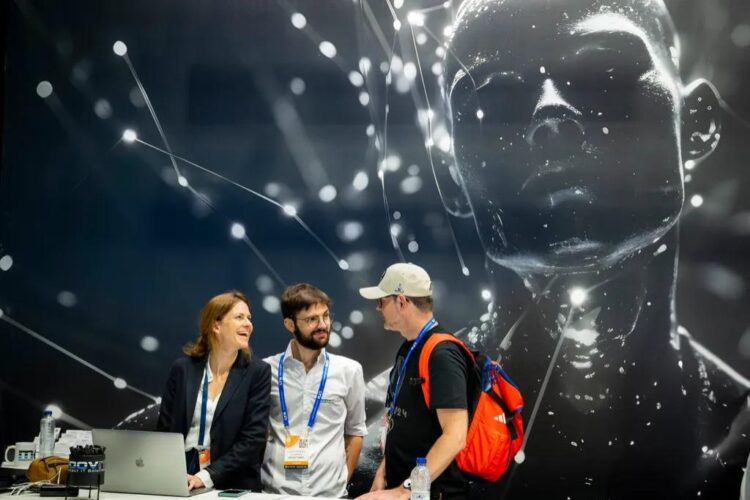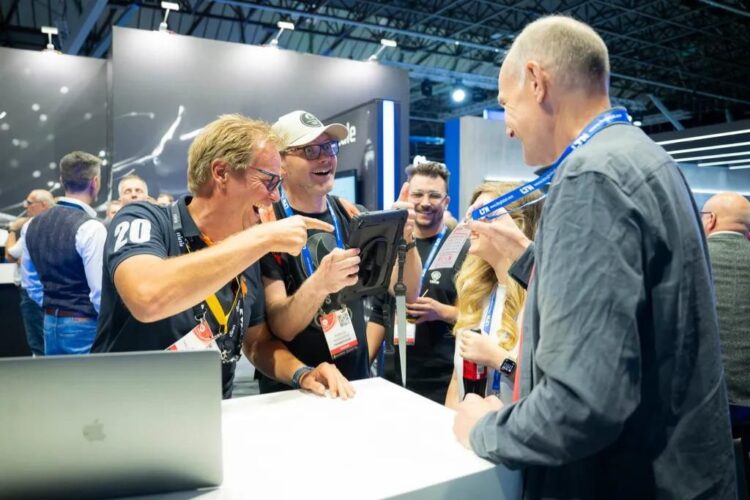IBC 2024: AI proves its star quality (even if consumers don’t notice)

Analysis
Artificial intelligence promises dramatic reductions in the future cost and carbon footprint of television as it migrates from broadcast to streaming. IBC also revealed how it will be possible to create even more TV in total, and give advertisers an inventory boost around live events.
The transition from broadcast to digital cannot — and will not — be derailed by the economic and environmental costs of streaming.
That was the most important message coming out of IBC 2024, the five-day annual showcase for TV technology innovation that closed on Monday, having welcomed 45,085 attendees from 170 countries to Amsterdam.
What we saw was an industry preparing for an acceleration in streaming consumption, especially on linear/live content, while providing ways to make unicasting more efficient — or maybe look beyond it.
Cost-busting
The exhibition floor was awash with video distribution technology that is helping to remove the cost and carbon associated with cloud video processing and content delivery networks (CDNs) — two of the foundational technologies for the current chapter in television network build and operations.
Artificial intelligence is providing a generational leap in intelligence to drive operations improvements.
Synamedia showcased its Quortex Play solution that can reduce cloud costs for broadcasters, streamers, and platform owners by up to 67% when delivering long-tail content (the mass of channels beyond the larger broadcasters). This is thanks to a pay-as-you-go cloud model combined with a just-in-time architecture that fires up server capacity for video processing only when someone requests a stream.
Ateme has applied new levels of intelligence to video processing and delivery with its Audience Aware Streaming solution. This uses viewing data (via the CDN) to understand which adaptive bitrate profiles are being watched (out of the versions available for a channel) and cease video processing for any that are currently unwanted.
Viaccess-Orca has created an AI model to understand the size of audiences and the CPU video processing demands that different types of programmes generate. A service provider can use this to scan next week’s programme guide and forecast its video processing server demands — then provision the capacity needed without over-booking.
Predicting audiences to plan cloud and CDN requirements is not new, but this level of intelligent automation is.
Re-engineering how streaming TV is delivered
IBC2024 also featured some stand-out innovations in how streaming video is delivered to the end user, through the network, each with the promise of dramatic cost and energy savings.
The most revolutionary comes from Eluvio, creator of the Eluvio Content Fabric, whose new partnership with Bedrock, the media-tech joint venture between broadcasters M6 and RTL Group, represents a massive vote of confidence in this technology as a solution for large-scale broadcaster streaming services.
Quanteec was demonstrating its peer-to-peer (P2P) solution that complements CDNs but allows media companies to offload 70-80% of the streams (from a CDN) during a large-scale live event. The company announced its first two major broadcaster customers recently — France Télévisions and Artear in Argentina — providing important proof-points for the technology (Orange is among other customers).
Another company that has re-engineered the way streaming video is delivered is Broadpeak with its multicast ABR solution. This is not new, but one major development is the addition of BT Group as a customer (with its own, slightly modified MAUD multicasting implementation).
BT was represented on the Broadpeak stand; so were the stakeholders in ‘The Catalyst’ sustainable live-streaming initiative that includes France’s Bouygues Telecom, TF1 and Italy’s RAI (all of which use the Broadpeak solution). They verified the impact of multicast ABR: 55% less live-streaming traffic on networks, 85% lower hardware requirements in networks, and 80% less energy consumption.
While cost savings are important, the stakeholders made clear they are motivated by sustainability requirements.
Making it easier to launch streaming services and channels
Another important story from IBC2024 was the extent to which it is becoming technically easier to launch streaming channels and services in the first place.
With advanced video processing and content delivery network architecture providing the foundations for accelerated streaming growth, there are a growing number of ways in which content can be enriched and re-used.
MediaKind showcased its MK.IO SaaS platform for live and on-demand streaming, together with its OTT platform solution, MK.IO Platform. The company said it can help international sports leagues and broadcasters at one end of the market, while enabling amateur organisations to stream events like school music performances and public court hearings at the other end.

The overall message: every media owner gets the highest quality and reliability, regardless of their size — with live content front of mind.
Deltatre announced the launch of its Core, Professional, and Enterprise packages for the D3 VOLT OTT platform solution. The Core version is designed to ensure that even small streamers get cutting-edge technology on a platform that is already used by top broadcasters, rights holders and global sporting organisations.
Harmonic, meanwhile, explained how a content owner can auto-create a FAST channel from library content with minimal human intervention. This process makes use of AI tools that understand content genres and themes. ThinkAnalytics was discussing its ThinkFAST scheduling solution for FAST channels, which also enables creation of new channels from existing content libraries. Substantial time and cost savings are promised by streamlining this otherwise labour-intensive task.
Maximising the value of content rights with wider distribution
Magnifi was demonstrating how live sport can be turned into on-demand clips for immediate distribution on social media, or as the basis for highlights packages. An AI tool can note the points where significant actions occurred (such as a goal or penalty kick in football).
For content owners with appropriate rights, clips are a way to further monetise the content in the minutes and hours after ‘broadcast’ when interest is highest.
Magnifi and Harmonic were among the companies demonstrating voice cloning for sports commentary, also using AI. This makes it easier to serve overseas markets and build fandom there.
Interra Systems was focused on translating closed-captions using ML and Natural Language Processing. This removes the substantial costs associated with teams of human translators and enables localisation of content (for new markets) where before it may not have been economic.
The further democratisation of high-end streaming service platform capabilities, easier creation of FAST channels, and improved economics for multi-market versioning, could mean consumers get even more television choice.
Generating new advertising inventory, including non-interruptive
There was plenty of good news for advertisers from IBC2024. More sports highlights clipping from leading media companies means more brand-safe, high-quality inventory. When consumers ‘rewind’ to a key event marker on their sports game timeline, a short pre-roll ad could be played before they watch the first goal of the game, for example.
Easier re-use of sport and other content in overseas markets could increase the total pool of premium video available to advertise against in any one territory.
Yospace and Ease Live both provided examples that first create new inventory and then immediately monetise it. Yospace showcased its partnership with Capella to help broadcasters launch pop-up streaming channels quickly and economically around live events, and use server-side ad insertion with addressable advertising to maximise value from the content rights, as with sport.
Ease Live also focused on live sport with its demonstration, although its solution for compelling interactive overlays can be used with general entertainment, like game shows, too.
With this solution, interactive graphics are delivered as an additional stream of content. Pop-up boxes can contain, as examples, team line-ups, match statistics and polls. Viewers select what they want to see.
Several Ease Live customers are reporting 25-30% longer viewing times thanks to interactive enhancements. Graphical overlays plus more attention adds up to new sponsorship and advertising inventory opportunities, including around the largest tentpole events. Sponsor logos can appear above the match statistics, for example.
Adjusting the length of ad breaks on a per-person basis
Adtech fans could hear about Amagi’s recently announced Zero Slate innovation, which adjusts the length of ad breaks on a per-viewer basis depending on how many ads are being targeted at them.
If there are four 30-second ads ready for Person A during a programme’s first ad break, they would see a fully filled two-minute break. But if there are only two (30-second) advertisers targeting Person B, their first ad break can be reduced to one-minute, avoiding the need for fillers, and avoiding slates, which are detrimental to the whole viewing experience.
Eventually both people must see the same number of content minutes before the next show starts, but Person B could be shown a trailer for a drama or movie at the end, to make up the time.
Amagi was also discussing its new ContextIQ AI-powered contextual advertising solution, which spins from a partnership with Anoki. This evaluates the suitability of scenes for an advertiser based on content and brand safety, harnessing multi-model generative AI.
Most spectacular AI lies in the back-end
AI, in its various guises, was the star of the show this year.
Previous highlights of IBC include more obvious consumer-facing innovations, like 3D television (which came to nothing) and multiscreen TV (which changed the world).
Former IBC stars from the backroom/operations category, like AI, include AVC compression. In the early part of this century, AVC-enabled multichannel HDTV, giving us the most compelling picture upgrade since colour TV and the reason to buy widescreen TVs. AVC also turbo-charged television over copper wires (telco IPTV) and the rise of streaming.
There are no signs yet that AI is going to unleash market-making forces like these, despite a rapidly growing collection of excellent applications and features that use it. The main impact of AI may be to improve the economics and environmental sustainability of the TV industry as it migrates from broadcasting.
Keeping the streaming show firmly on the road, with headroom for rapid growth, is what we all need. The dedication to this task was the big takeaway from Amsterdam.
 John Moulding is an editorial consultant for media and entertainment industry and was previous editor-in-chief of Videonet.
John Moulding is an editorial consultant for media and entertainment industry and was previous editor-in-chief of Videonet.




